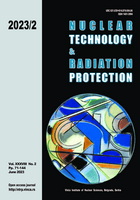
ENVIRONMENTAL PROTECTION IN NATURAL GAS INDUSTRY Comparison of Different Spatio-Temporal Radiological Risk Assessment Scenarios

Vol.
XXXVIII, No. 2, Pp. 71-144
June 2023
UDC 621.039+614.876:504.06
ISSN 1451-3994
Pages: 135-143
Authors: Ana Getaldić, Marija Surić Mihić, Želimir Veinović, Božena Skoko, Branko Petrinec, and Tomislav BituhAbstract
The paper analyses results of spatio-temporal radiological risk assessment scenarios based on existing in-situ long-term monitoring data from a natural gas processing plant to analyse the effect of different input data on the assessment outcome. The ERICA Assessment Tool was used to estimate the dose rates to biota and potential impacts due to the exposure to ionising radiation. The input data for radiological risk assessment scenarios included annual data on activity concentration of radionuclides in soil from in-situ measurements performed from 1994 to 2016 and laboratory gamma-spectrometric data related to the period from 2014 to 2019. Predicted total dose rate to biota was generally below the ERICA Tool's screening dose rate of 10 µGyh–1 or slightly above, with the highest total dose rate estimated for lichen and bryophytes. Total dose rates to lichen and bryophytes in the studied period show certain temporal variation, but a specific trend was not detected. Estimated total dose rates to biota from different assessment scenarios were below internationally proposed reference levels for which no detrimental effects are expected. The overall potential radiological risk to terrestrial biota from the operation of the natural gas processing plant was found to be negligible.
Key words: NORM, natural gas, radiological risk assessment, environmental protection, Erica tool
FULL PAPER IN PDF FORMAT (569 KB)